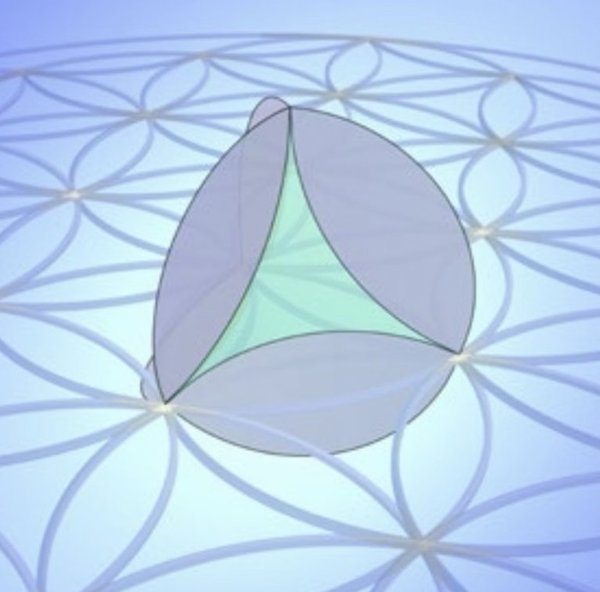Lesson
Introduction to Lynchpin: A Geometric Perspective
Terrence Howard's Lynchpin presents a unique and unconventional approach to mathematics and physics. At its core, it proposes a new way of understanding the universe based on geometry and harmonic resonance, challenging some traditional scientific concepts.

The Foundation: Unity and Interconnection
Lynchpin is built upon the idea that when two entities combine, they create a distinct third entity, emphasizing interconnectedness. This principle extends beyond simple addition, suggesting a more complex and holistic interaction.
Introducing the Tetryen
A fundamental element in Lynchpin is the "Tetryen." Imagine a curved tetrahedron (a pyramid-like shape with four faces). According to Howard, this specific tetrahedral structure arises from four points resonating harmonically. It's not just a shape; it's considered the foundation for a new way of visualizing geometry and dynamics.

The Howard Comma: Adding Curvature and Energy
The "Howard Comma" is another key concept. Think of it as an operator that introduces curvature and energy flow into calculations. It bridges the gap between standard scalar math (dealing with magnitudes) and spatial geometry (dealing with shapes and their relationships). This means that mathematical operations can account for the energy and dynamic properties of objects, not just their size.
Lynchpin and Drones: Tangential Flight
One of the most intriguing applications of Lynchpin is in drone technology. Howard's designs focus on "tangential, omnidirectional flight." This means the drones can move in any direction simultaneously, offering significantly improved maneuverability compared to traditional quadcopters.

Six Degrees of Freedom
Traditional drones, limited by their rotor configuration, often struggle with complex movements. Lynchpin-inspired drones, based on the symmetry of the Tetryen structure, are designed to achieve six degrees of freedom. This means they can move:
- Forward/Backward
- Left/Right
- Up/Down
- Pitch (tilting forward/backward)
- Yaw (rotating horizontally)
- Roll (tilting side to side)
This enhanced agility has potential applications in search and rescue, surveillance, and various other fields.
Modular Flight: Drones Connecting in Mid-Air
Another exciting aspect is the possibility of modular drone systems. Because of the shared center of symmetry within the Lynchpin structures, individual drones could lock together while flying. This creates a dynamic, reconfigurable system. Think of it like building a larger structure in the air, or a swarm of drones cooperating to perform complex tasks.
The Geometry of the Proton: A New Perspective on Subatomic Particles
Beyond drones, Lynchpin extends to theoretical physics. Howard proposes a geometric model of the proton, one of the fundamental particles in atoms. Instead of viewing protons as simple point charges, he envisions them as complex spatial structures formed by interlocking Tetryens.
Protons as Assemblies of Harmonic Nodes
In this model, protons are seen as assemblies of smaller components (like electrons and positrons) trapped within specific, geometrically defined positions. These components exist as standing waves, creating a stable structure based on the Lynchpin geometry. This offers an alternative to the standard quark model of particle physics.
Curved Multiplication: A Different Kind of Math
Howard also introduces the idea of "curved multiplication." He argues that traditional multiplication is too linear and doesn't accurately reflect the curvature and complexity of real-world interactions. Curved multiplication aims to incorporate factors like time, energy, and force into mathematical calculations, allowing for a more dynamic representation of reality.
Hyperbolic Curvilinear Space: A New Framework for Physics
Building upon this, Howard proposes a "Hyperbolic Curvilinear Lattice Space." This mathematical lattice describes a universe where all physical constants interact nonlinearly and symmetrically. It suggests that space itself is curved and that energy propagates in a harmonic way. This framework could potentially provide a foundation for understanding how matter forms, how energy is transmitted, and even how consciousness arises.
Patents and Prototypes: Bringing Theory to Life
Howard has filed patents related to Lynchpin propulsion systems, modular drone connection systems, and even virtual reality interfaces that visualize these concepts. These patents suggest practical applications for his theoretical work, ranging from advanced engines to interactive learning environments.
Challenging the Standard Model
Lynchpin challenges some core tenets of modern physics, including the Standard Model of particle physics and Einstein's General Relativity. Howard argues that these models may overlook the importance of harmonic resonance and geometric motion in the universe. He proposes that the universe is fundamentally composed of self-organizing harmonic structures, governed by curvature and symmetry.
Open Science and Exploration
Howard encourages open scientific inquiry into his theories. His website is designed as an educational resource, featuring diagrams, animations, and downloadable models. He invites researchers to explore, evaluate, and potentially replicate his work, fostering a spirit of collaboration and discovery.
A New Paradigm?
Ultimately, Lynchpin presents a vision of a unified geometry where flight, matter, and thought are all interconnected. It proposes a new way to understand the universe, potentially inspiring new approaches to quantum mechanics, aerospace engineering, and our understanding of reality itself.
Summary of Key Concepts
Here is a brief summary of the concepts discussed:
- Lynchpin Foundation: Emphasizes that two united entities create a third, unique entity.
- Tetryen: A curved tetrahedron formed from harmonic resonance, the foundation for Lynchpin geometry.
- Howard Comma: An operator adding curvature and energy flow to calculations.
- Tangential Flight: Drone technology enabling movement in any direction, based on Tetryen symmetry.
- Modular Flight: The ability of drones to connect mid-air, creating reconfigurable systems.
- Geometry of the Proton: A model where protons are spatial structures formed from interlocking Tetryens.
- Curved Multiplication: Multiplication that includes time, energy, and force, enhancing real-world accuracy.
- Hyperbolic Curvilinear Space: A framework for physics where physical constants interact nonlinearly.












